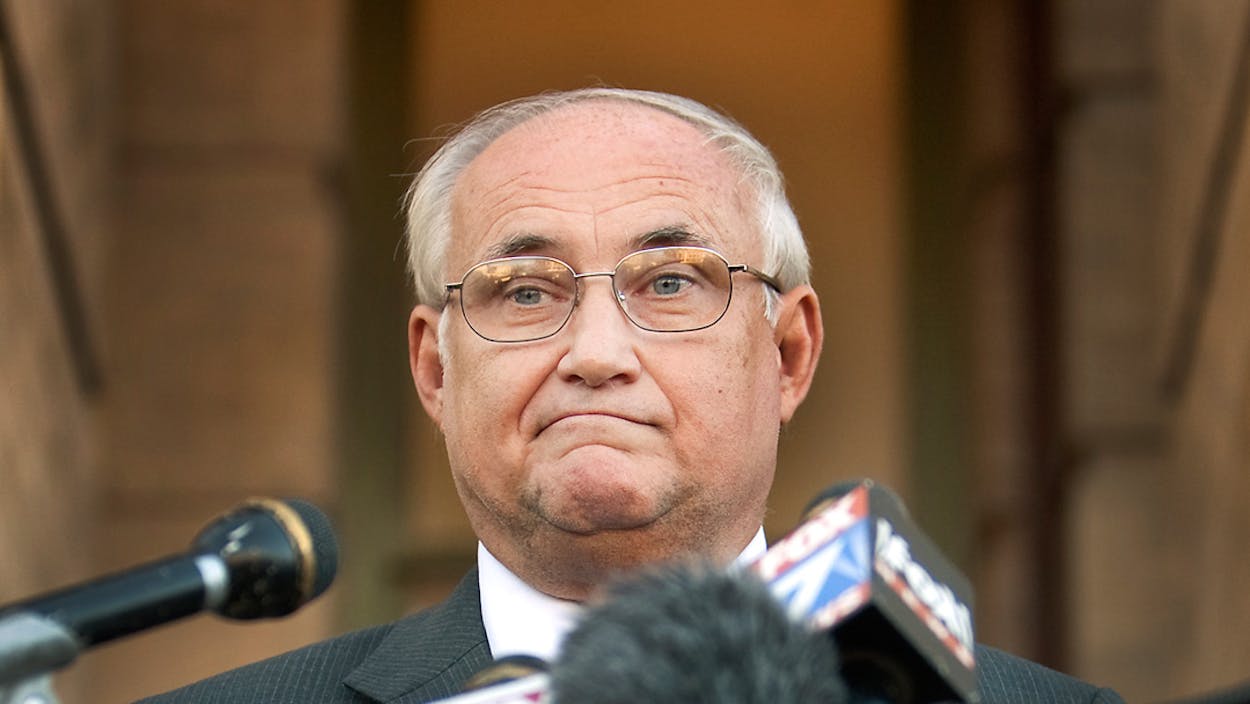Twenty-six years ago this month, Michael Morton sat inside a Williamson County courtroom, accused of murdering his wife, Christine, while then-D.A. Ken Anderson argued passionately before the jury that the Austin grocery store manager should be convicted and sentenced to life in prison. Yesterday, the roles were reversed. This time, it was Anderson—now a state district judge—who sat at the defense table. With his head bowed for much of the proceedings, Anderson listened to testimony that will help determine whether or not he should face criminal charges for allegedly withholding evidence that could have helped Michael prove his innocence at his 1987 trial.
A court of inquiry into Anderson’s alleged prosecutorial misconduct began yesterday with Michael Morton taking the stand. Trial lawyer Rusty Hardin—who is serving as the inquiry’s “attorney pro tem,” and who must present witnesses and evidence to state district judge Louis Sturns to determine if an offense has been committed—asked Michael about several documents that have come to light which his defense lawyers never saw at trial. They included a transcript of Michael’s mother-in-law informing an investigator that her three-year-old grandson had told her that he had witnessed the murder. The boy told her that “a monster”—not his father—had beaten his mother to death, and Michael’s mother-in-law in turn told law enforcement what her grandson had said. Michael explained that he had never known of the transcript until his attorneys uncovered it in recent years under an open records request. “It was a complete shock to me,” he said.
Michael also recounted how the late Williamson County sheriff, Jim Boutwell, had focused on him as the prime suspect from the very beginning. “I felt like I was collapsing into myself,” Michael explained, of learning that his wife had been bludgeoned to death in their bed. “I was mechanically answering questions.” He described being reunited with his three-year-old son, Eric, hours after the killing. “He was very distraught…” Michael said, his voice choking with emotion before he trailed off. Much of his testimony that followed centered around Eric—specifically how much of the murder, if any, the boy had witnessed, and what, if anything, he had told Michael about the man he saw at the crime scene.
What were the nearly 25 years he had spent behind bars like, Hardin later asked Michael? “Brutal,” Michael replied. “But after a couple of decades I got used to it.”
“What did you get used to?” asked Hardin.
“I got used to lack of privacy, restriction of movement, violence, the forced associations, the lack of” —he paused for a moment to compose himself—“seeing my son. The million and one little things that you take for granted that you can’t even imagine: clothes that are comfortable, people who are honest, food that tastes good, a comfortable bed to sleep in.”
What was his reaction, Hardin wondered, when he learned that Anderson might have held back exculpatory evidence such as the transcript of his mother-in-law calling police?
“I was stunned,” Michael said. “Why? For what purpose? What motivation?”
Anderson did not register any visible reaction to Michael’s testimony. He kept his head down, his eyes focused straight ahead of him. Behind him, the courtroom was jammed with rapt spectators and local attorneys who slipped in between court appearances to listen. One of the observers included Lou Bryan, a local schoolteacher who served on Michael’s original jury back in 1987. State senator Rodney Ellis, who has led the charge for criminal justice reform in Texas, was also in attendance, as was Innocence Project co-director Barry Scheck. Caitlin Baker—whose mother, Debra Baker, was murdered two years after Christine—also observed the court proceedings with family members. (Recently discovered DNA evidence links the crime scene of Debra Baker’s murder and the Morton murder to a drifter named Mark Alan Norwood, who will stand trial this March for killing Christine.)
Even after everything he had been through, Hardin asked, how did he manage to not be consumed by bitterness?
“Grace of God,” Michael said. “I don’t want revenge. I don’t want anything ill for Judge Anderson. But I also realize that there are consequences for our actions and there needs to be accountability. Without that, everything falls apart.”
And what did he want the court of inquiry to accomplish, Hardin asked?
“I ask that you do what needs to be done,” Michael said, directly addressing Judge Sturns as he wiped away tears, “but at the same time, to be gentle with Judge Anderson.”
Anderson’s attorney, Eric Nichols, deftly debunked one of the principal accusations that Michael’s attorneys at the Innocence Project have made over the past year and a half: that an old phone message in the sheriff’s file seemed to indicate that Christine’s credit card had been used two days after her murder in San Antonio, and that law enforcement had not followed up on the tip because investigators were so certain that it was Michael who killed her. In fact, Nichols showed that Christine’s wallet had never been stolen at all, but had instead been taken from the crime scene by investigators from the Texas Department of Public Safety. To prove his point, Nichols showed DPS photos of Christine’s wallet and her credit cards to Michael and asked him to identify them.
But Hardin was unimpressed. Whether the phone message in the sheriff’s file was accurate or not was irrelevant. “The file is replete with stuff they should have let the defense attorneys have to decide whether they were things that were helpful to have,” he stated toward the end of the afternoon, adding that the state appeared to have routinely withheld critical items from the defense. “The fox doesn’t get to guard the hen house, and that’s what I’m seeking to prove here,” he stated.






